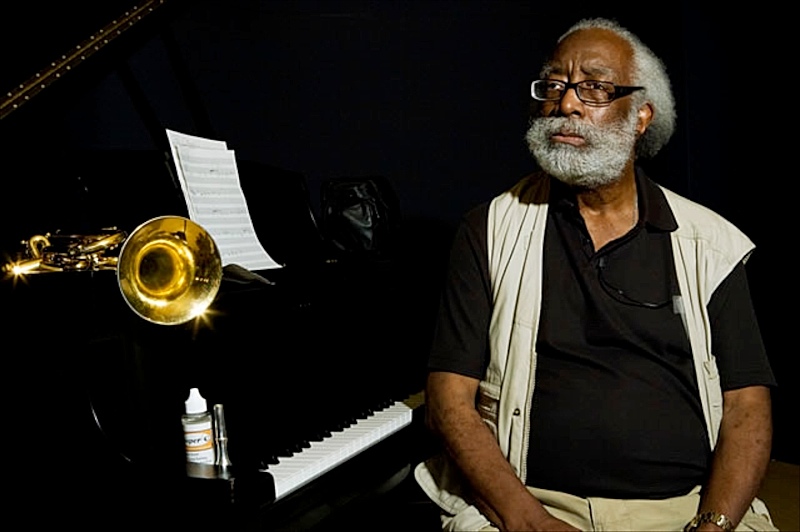Had the pleasure and good fortune to study with the eminent Bill Dixon, back in the day. If you don’t know much about him, you should. Or, if you’re interested in reading some more of his thoughts, try this interview at AllAboutJazz:
Bill Dixon: An In-Depth Look Into The Accomplishments, Philosophies, And Convictions Of The Man
Sunny & 70s Somewhere – by Justin Perdue
Demo sketch of a new original latin jazz number of mine: “Sunny & 70s Somewhere”
Found a scrap of paper with the chords the other day, and rescued the half-remembered melody from the abyss of my iPhone voice memos. It’s yours truly playing all the parts: the dubbed guitars are “rhythm” guitar on my Eastman archtop as an electric (with the amp mic’d), and the solo is the same Eastman with the f-hole mic’d and the electric direct – gives it a nice acoustic sound, I thought. Dusted off the not-so-trusty old guitar synth, and after a few takes, got a glitch-free bass track. Will get a proper duo or small group recording soon – stay tuned…
notes on tuning guitar in fourths

Influenced by the chord voicings employed by McCoy Tyner and the harmonic patterns used by John Coltrane, Justin Perdue began tuning his guitar in fourths (E-A-D-G-C-F, low to high) in 1990. Initially, this was intended as an experiment to explore that possibilities it opened up for more symmetrical scalar patterns and chord voicings than the conventional guitar tuning – and also to develop “outside-the-box” guitar techniques that his studies with trumpeter Bill Dixon encouraged.One of the immediate (and lasting) effects of this change is that standard bar chord voicings and open position chords are no longer workable options. As it turns out, many guitar cliches one takes for granted become significantly altered – making one realize that these phrases have become cliches due to how readily they fall under the fingers in conventional tuning — a convenience which is often not the case when tuning in fourths.
By the same token, the 4ths tuning lends itself to its own set of cliches spawned from certain types of more easily executed phrases and voicings. For example: Any chord voicing spanning 4 strings can be transposed by simply moving to any other set of strings without changing the fingering. Octaves, for instance, use the same fingering regardless of the string pairs being played. The same holds true for any scalar patterns – gone are the asymmetries resulting from the third between the G-B strings in standard tuning.
So, while tradeoffs include some oddities — for instance trying to cop a Wes Montgomery line or chord solo note-for-note may or may not fall under the fingers more readily in all fourths tuning — the symmetrical nature of the fourths guitar tuning greatly simplifies playing one of Wes’ signature octave runs. Similarly, Coltrane’s pentatonic and sheets of sound patterns are readily transposed anywhere on the fretboard without changing the fingerings.
Read & learn more about the tuning at the Guitar Tuning in 4ths group on facebook.
choosing not to pick

In pursuit of the tone – namely the sound of Wes Montgomery – I abandoned using a pick several years ago. While it has is drawbacks when I’m looking to strum (especially in say a funk context) I’m a convert otherwise: It’s fine for comping, and great for chord soloing and single-note octave lines. I find it affords a much greater range of tonal colours and expression: Virtually never use the volume knob anymore, except to set an initial level, any volume modulations I need can be accomplished in a “tactile” manner. For that matter, I never end up touching the tone knob, as a wide range of tonal colours are a literally at ones fingertips when playing without a pick. While Wes only used his thumb while resting his fingers on the guitar, I’ve found using my index, middle and (on occasional) ring fingers – in a sort of hybrid classical guitar technique, though without any nails – is what’s working for me.
At the time I became interested in choosing not to pick, I was also looking for a way to more readily execute wide intervallic leaps, and integrate right-handed tapping techniques. Not so much in the interest of being the next Van Halen, but actually in pursuit of certain Coltrane/Dolphy-type possibilities. Conventionally cross-picking a line of wider intervals that alternate between, say, the low E/A strings with the top strings always struck me as a lot of work (a job best left to the John McLaughlins of the world). Finger-picking these types of intervals is comparatively simple, however.
So, though I certainly can’t recommend ditching the pick for guitarists across the board – I’d definitely in the camp that it has it’s merits for the jazz player in search of a warmer, more pliable tone, and perhaps the opening of other some doors leading to different shapes in your lines.


